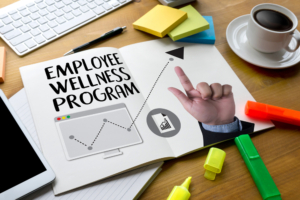Health and Wellbeing, Corporate Wellness, Wellbeing at Work and Wellness Programmes are all phrases that you may have heard of in the media or read about.
What exactly do they all mean? Let’s start with a definition:
Wellbeing in the Workplace is:
“That part of an employee’s overall wellbeing that they perceive to be determined primarily by work and can be influenced by workplace interventions.”
 Wellness is also described as a combination of preventing and managing ill health, and promotion of health and safety.
Wellness is also described as a combination of preventing and managing ill health, and promotion of health and safety.
Why though are we seeing and hearing so much in the media about our employee’s wellbeing?
Here are a few startling facts, at least they were to me:
- Sickness absence costs UK businesses an estimated £16 bn each year, with the average worker taking 6.6 days off each year due to sickness. (1)
- The number of people suffering from mental health problems at work, such as anxiety, stress and depression, has risen from a quarter to a third over the past five years. (2)
- Mental ill health costs the UK economy £100 billion each year (against a total NHS budget of £115 billion) (3)
- One in six deaths in the UK occur in people of working age (4)
- Fewer than one in 10 (8%) of UK organisations have a standalone wellbeing strategy. With many relying on one-off initiatives (2)
Why Wellbeing and Why Now?
Workforce demographics have changed and we are all aware of our ageing population, we also know how industries have changed. The type of employment we have now, compared to 30 years ago, is very different. Industries such as manufacturing have declined while, for example, the service sector, financial industries and technology industries have grown significantly.
In addition, though, expectations have changed, employees are looking for flexibility in the workplace with many looking to change their work hours, work from home and have the ability to create a better work/life balance for themselves and their families.
While there are multiple factors at play here, as leaders in organisations we do need to step back and look at what is happening in the corporate world. After all, we spend so much of our lives at work
Let’s explore this a little further with an example:
For many years now, business enjoyed exponential growth. Each year companies increased their targets, raised profit expectations and along with this, they raised their expectations of their employees.
Yes, the financial crisis hit many industry sectors harshly – how did organisations respond?
Now, this may sound over simplistic but essentially the response was, ‘do more with fewer people’.
While technological advances mean we can achieve far more in less time than we dreamed of even 15 years ago, it is the employee that has seen the brunt of consistent change and ever increasing expectations and demands.
At the risk of being controversial, who has heard of an organisation who set goals of “same as last year” except for people investment. This year our goal is only to invest in creating the right culture and work environment.
To encourage our employees to focus on their health and wellbeing, and supporting them with a programme of activities ranging from yoga to nutrition, advice to exercise classes and offering extra holidays to those who walk or cycle to work.
The reality is that the above just hasn’t happened. What is happening is employees are increasingly reporting they are experiencing stress, anxiety and depression that is work related.
The question is what do organisations and leaders do about this?
1. Change their mindset of how to grow the business and generate profit.
 The following quote raises some valid points.
The following quote raises some valid points.
“The wellbeing of employees is influenced by their genes and lifestyle, but also by work and its organisation. Many wellbeing programmes focus on individual and lifestyle risk and appear to underplay the significance of work and the workplace. At worst, they may be doing no more that promoting resilience so that employees can withstand ongoing stress.
To be successful, workplace wellbeing activities must be comprehensive and address both individual and occupational risks, including physical and psychosocial environments at work (Goetzel, 2014; Kuoppala, 2008).” (5)
It could be argued that todate Wellbeing programmes are geared towards helping employees become more resilient so they handle the work environment and pressures better.
The above suggests organisations need to look at how they are approaching Wellbeing to reap the rewards for their people and then the business.
2. Lead the change by having leaders as role models. Leaders who participate in wellbeing activities and demonstrate a healthy work/life balance.
Here’s a quote from Beth Taylor, the mental health leader at PwC.
“The firm recently launched a group of six mental health advocates to support the de-stigmatisation of mental health. They are all partners in our firm. We wanted leaders to talk about their experiences of mental health. We asked them to be senior role models and figureheads for mental health. Our colleagues can approach them on a one-to-one basis and talk to them about their own experiences and concerns. We don’t want these partners attempting to resolve any underlying mental health issues – they’ve been trained by the Samaritans to offer non-judgmental listening, empathy and signpost people to sources of external or internal help.”
In my role as Commercial Director at Excel Communications, I am aware of the example I set in terms of work life balance. Being honest, for years in previous roles I didn’t take a proper break at lunch, by mid-afternoon I was aware that I would grab a sugar or caffeine fix to pep me up. If it was a more challenging day it could be both!
Over recent years though I have become increasingly aware of the impact not only on my own wellbeing but the unconscious messages I was sending to my team. I decided it was time to create some new habits. The first is to take a lunch break away from my desk. The second is to take a short walk by the river here in Marlow. (I know, how lucky am I to have it on my office doorstep.)
By taking this break I do return to my desk feeling fresher and I know I have had some exercise.
(Gets me closer to my Fitbit step goal too.)
3. Invest in developing a wellbeing culture in your organisation.
 A growing number of businesses are encouraging their employees to be healthy and emotionally resilient through a new generation of wellness intervention schemes and it isn’t just corporate companies who are leading the way.
A growing number of businesses are encouraging their employees to be healthy and emotionally resilient through a new generation of wellness intervention schemes and it isn’t just corporate companies who are leading the way.
The winners of Britain’s Healthiest Workplace small company award were Forster Communications.
They have developed initiatives ranging from offering pedal points; five minutes’ additional holiday for every return journey walked or cycled to work, to free breakfasts, sabbaticals for staff with over five years’ service, and flexi-time hours and flexible working conditions.
Adidas UK won the medium company award (250-999 employees), while Nomura International PLC were winners of the large company award. (1000+ employees)
The point here is, company size doesn’t matter. What does matter is having leaders in a business
who decide to put employee health and wellbeing at the heart of their culture.
Here at Excel Communications we aim to practice what we preach; we are a pet-friendly company with a couple of resident dogs, and have introduced wellbeing activities such as coulouring canvases.
What are you doing in your organisation to create a Health and Wellbeing culture? I would be interested to hear your stories.
Excel Communications has over a 30-year history as a global leadership and communication skills organisation dedicated to exceeding the expectations of clients through the training and development of their business and people.
We have a team of expert trainers delivering programmes across four continents in multiple languages. Isn’t it time you got in touch? Call us now on +44 (0) 1628 488 854.